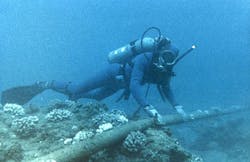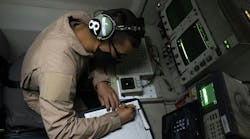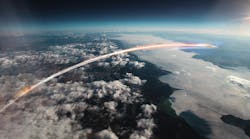Officials of the Space and Naval Warfare Systems Command (SPAWAR) in San Diego issued a sources-sought notice last week for the Undersea Cable System and Sonar System Technology Advances program, which seeks to capitalize on commercial ocean cable technology for maritime surveillance.
The term maritime surveillance generally refers to sonar listening arrays installed on the ocean bottom in strategic areas like the Greenland-Iceland-United Kingdom (GIUK) gap, the Straits of Florida and Yucatan Channel gateways to the Gulf of Mexico, and the Strait of Malacca in Indonesia.
Governments and international authorities generally keep close surveillance of these strategic waterways to measure ship traffic and track the locations and movements of military surface ships and submarines. The SPAWAR sources-sought notice is numbered SPAWAR_Headquarters_MKTSVY_EFA72.
Related: SAIC joins APS in DARPA project to develop deep sonar to detect quiet hostile submarines
Navy fixed-site undersea sensor systems today include the Fixed Distributed System (FDS) and the Sound Surveillance System (SOSUS), which are deployed in strategic ocean choke points.
In addition, sonar experts at the U.S. Defense Advanced Research Projects Agency are working with Science Applications International Corp. (SAIC) in Arlington Va., and Applied Physical Sciences Corp. (APS) in Groton, Conn., on the Deep Sea Operations (DSOP) program.
The DARPA DSOP program seeks to design technology for an extremely deep-operating anti-submarine warfare (ASW) system to help protect U.S. Navy aircraft carriers and their support vessels from quiet enemy attack submarines.
For the Undersea Cable System and Sonar System Technology Advances program, SPAWAR experts would like to learn about technology advances in the telecommunications and oil and gas industries, as well as new technologies in industry and academia that could improve performance and reduce costs o maritime surveillance systems.
SPAWAR experts particularly are interested in undersea data transport and power distribution networks; network sensing and management; auto fault localization and correction; data transport; underwater connections for modular systems expansion; installation and protection methods; remote sensor integration; improved array configurations and construction; and compact remote power sources for stand-alone systems.
Related: Navy seeks to enhance undersea surveillance to optimize anti-submarine warfare operations
SPAWAR will brief industry on their needs during industry day presentations involving classified and unclassified briefings, as well as industry meetings, on 15 July at SPAWAR headquarters in San Diego. RSVP for the industry briefings no later than 8 July 2014 to the Navy's Don Ringel by email at [email protected], or by phone at 858-537-0112.
Those interested should submit white papers no longer than 50 pages online to SPAWAR at https://e-commerce.sscno.nmci.navy.mil/. Email questions or concerns to the Navy's James Leal at [email protected].
More information is online at https://www.fbo.gov/spg/DON/SPAWAR/SPAWARHQ/SPAWAR_Headquarters_MKTSVY_EFA72/listing.htm.



